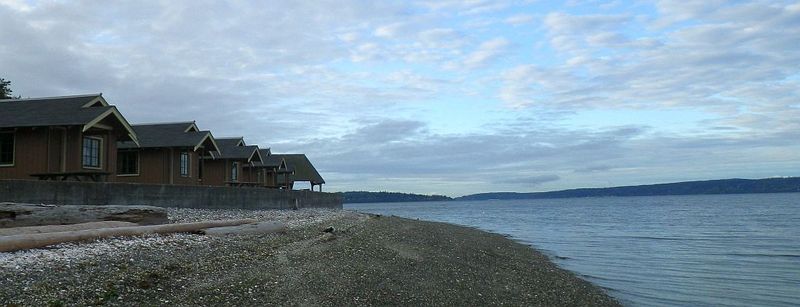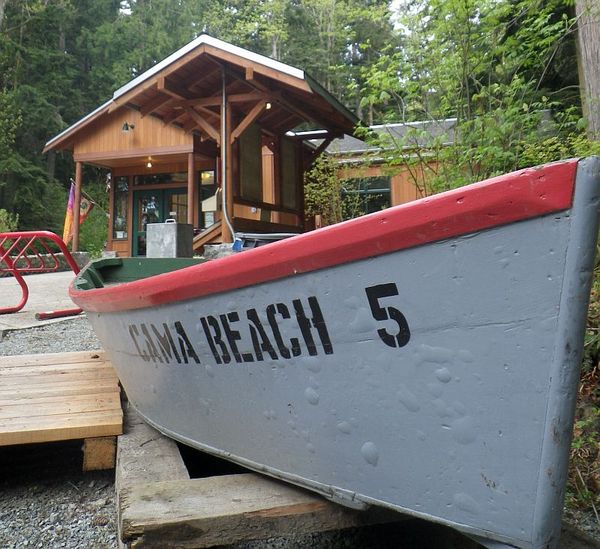
I am sitting on the banks of the Puget Sound this evening, waiting for dinner, and enjoying the beautiful scenery of western Washington state. Under my feet is a pebble beach, a log for my butt, behind me is a well ordered row of woody cabins. In front of me is a mile wide stretch of water about 48 degrees but crystal clear and full of sea lions, otters, salmon, dungeness crabs, and gray whales. On the other side is Whidby Island, framed at times by the even more distant but majestic Olympic Mountains. Rising to over 12000 feet, their snowy crags are a reminder of the youthful vigor of the landscape, the restless Pacific Rim. Eagles chatter and whistle from the giant cedar trees and the lapping of the water are all that meets the ears.
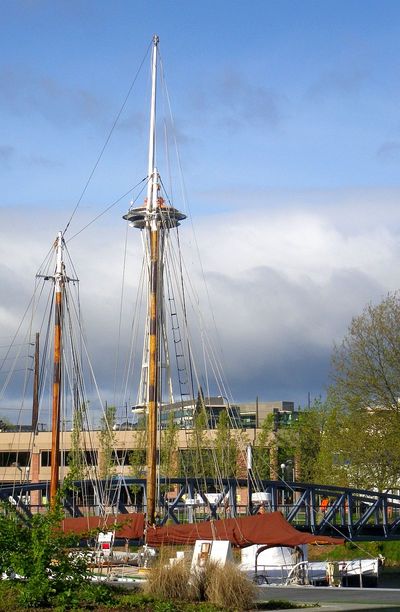
No trip to Seattle would be complete without a shot of the Space Needle, but I thought I’d add the flair of the conference to this picture. Superposed on the Space Needle is the mainmast and rig for the schooner Lavengro, a beautiful 1920s Biloxi lugger now sailing Lake Union.
But that us not why I am here. LAMP sent me here to learn from the best institutions in the country who build wooden boats and train young people in solid math and science skills using a philosophy that ‘boats build people’, not the other way around. Groups from all over the country are here to share their success stories in programming and it has been an astounding success. How do I measure this success? The 80 or so participants who have participated this weekend have kept a remarkable energy going to blend ideas, come up with new ones, and refine existing concepts of how to make our young people better, smarter, and stronger. While we do many of these things at the Lighthouse Museum with our education programming, we are thinking about making the LAMP Boatworks more of a part of this. It has been a successful part of the museum and deserves to share its skills with a broader group.
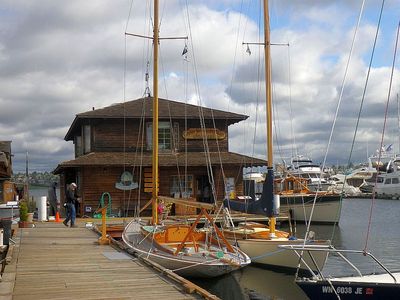
The Center For Wooden Boats, Seattle Washington.
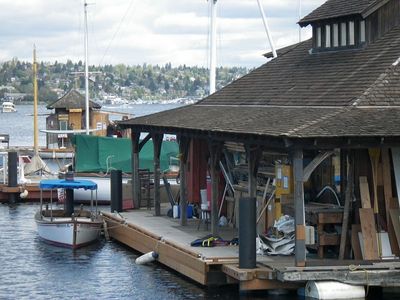
The CWB floating workshop.
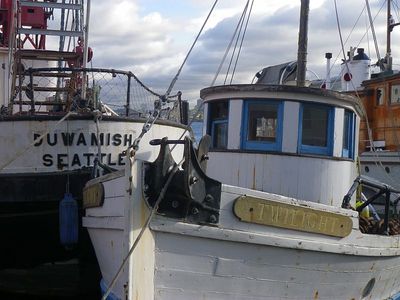
Seattle is a yotty place!
I arrived last week in Seattle on Thursday night and checked into a downtown hotel. The next morning walked down to the Center for Wooden Boats, our primary host for the first part of the training conference. Conference attendees were showing up and by noon we met and began. After an orientation at the South Lake Union center, visiting with dozens of their boats, we loaded into vans and trekked up to Camano Island to Cama Beach State Park. This park, only four years old, is a revitalized fishing camp from the early 20th century right on the Puget Sound, Saratoga Pass to be exact, and consists of about 30 cabins on the water with a great hall up the hill behind the cabins. We checked into our cabins and instruction began.
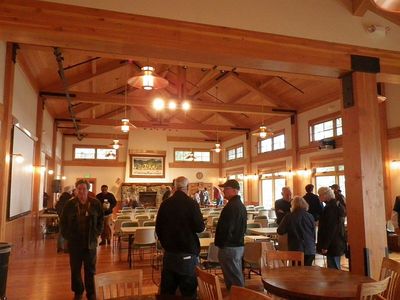
Conference attendees arriving…
As I looked around, nametags bore the names of institutes from all over the country. Alexandria Seaport Foundation, Hull Lifesaving Museum, Mystic Seaport, Lowell’s Boat Shop, Foss Waterway Seaport, Independence Seaport Museum, and many more groups were represented. The four corners of the country were well represented. An opening session officially started the conference and we were welcomed by our host, the Center for Wooden Boats (CWB). Betsy Davis, the Executive Director for the CWB welcomed us along with the original founder of the CWB, Dick Wagner. Also on hand were the steering committee members for the Teaching With Small Boats conference. The idea behind the conference is one that goes back many years and originated as an idea-sharing consortium of like-minded maritime organizations. For the next two days we would work together roundtables, hands-on workshops, and around the campfire to share our own stories. Each attending organization is somehow involved with teaching students. From young people struggling with mathematics to young adults learning the skills it takes to get a good job, boatbuilding organization across the country are doing an amazing amount of good to make the art of building, using, and loving small boats a meaningful and valuable asset.
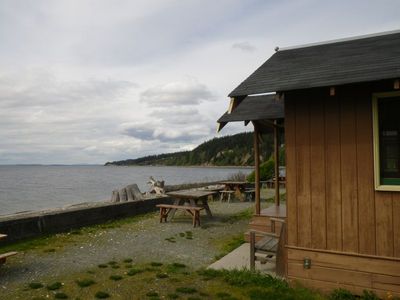
Our cabins on the beach, Saratoga Pass in the background.
After the opening session, we retired to the campground and the late evening twilight common in the high latitudes. Early on Saturday morning I joined John Mullen to learn about the art of native canoe carving. John is a member of the Swinomish, a local native group and part of the Coast Salish. The canoe building traditions of this area are reknown and we were lucky to have two of the great canoe carvers on hand to learn from. Saaduuts, program coordinator for the CWB’s Carving Cultural Connections, was also on hand and guiding workshops in how to carve native canoe paddles. The two instructors teach students of all ages self confidence, connection to their natural world, and patience. Both gentlemen have built great canoes that will ply the waters of the Puget Sound for generations. As they worked, they talked about how the process of creation begins, how to get students who are shy to hold a tool and let them express themselves positively through creation. For every emotion there is a task, for each task a tool. Fit the right emotion with the right tool and the task will accomplish itself. I can imagine after only an hour or so with these two guys that young people who have spent hours, or days with them are better for it. In addition Saaduuts opened and closed each day with a native Haida song for us all. How awesome?!
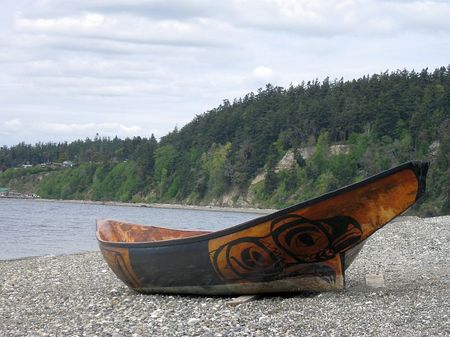
What a cool canoe!
Learn more about the native carving tradition at the CWB here.
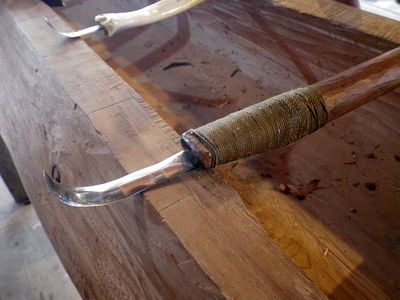
A giant canoe can be carved with a little tool like this!
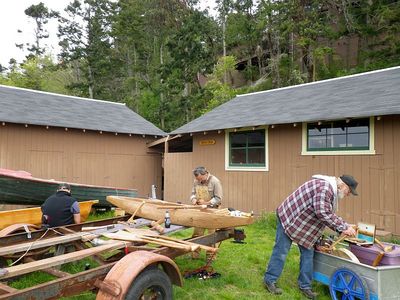
Demonstrations of native canoe carving.
Mid morning I journeyed up the hill to the great hall and joined a panel of speakers in discussing “Linking Instruction to National Standards”, led by Art Sulzer (Maritime Academy Charter High School) and Scott Rizzo (Montrose CO, NROTC). The key concept is the importance of having educational programming aligned with federal Common Core Standards as well as individual state initiatives. While there is a lot to go into about this I will not bore you with the minutiae of educational standardization!
After lunch I took the opportunity to go for a quick paddle in a beautiful canoe carved by Saaduuts. His grandson and a friend took a couple of us out on the chilly but clear waters of Saratoga Pass and we got to experience the feeling of a northwest seagoing canoe. Despite how big they are, the canoes (NEVER call them boats, I learned!) are quite fleet and easily handled. I learned that to beach a canoe on someone else’s beach you back your way in to the beach and ask permission to land. Its a nice way of being humble and, just in case you don’t get it, you are ready to haul butt!
Exchanging life jacket for pen and pad, I went back up to the great hall to attend a session led by Dana Hewson about the Whaleboats Program. Mr. Hewson is the Vice President for Watercraft Preservation & Programs for the Mystic Seaport Foundation in Mystic, Connecticut and is responsible for the restoration of America’s second oldest floating ship, the whaleship Charles W. Morgan. The Morgan is undergoing her largest refit and reahbilitation since her construction in 1841. The old girl, after 37 circumnavigations, 80 years of whaling, and decades as a museum ship and America’s last whaler, was in sore need of help to keep her alive. Mystic Seaport is substantially rebuilding the whaleship so she will again sail her home waters. However, a whaleship is ‘nere complete without her whaleboats. These 28’ wooden boats were specifically designed to withstand long periods on the ship’s deck, being suspended from davits (notoriously hard on wooden boats), launched into wild seas to persue whales under sail and oar power, and finally to tackle the great beasts of the seas. Any of us who have read Melville’s Moby Dick or seen Harper’s Weekly lithographs from the salad days of whaling have engrained the indelible image of a whaleboat being tossed by an enraged sperm whale, whalers flung hither and yon, but the boat surviving. Sometimes they did not, but the boats often underwent dramatic torture that would reduce lesser craft to splinters and consign their crews to the deep. And so, the Morgan will have a full fleet of whaleboats once more, to capture and present an era of our history that is as interesting as it was environmentally devastating. I attended this session to learn about the progress of the whaleboats project as well as learn about how the project is set up and run, since LAMP Boatworks is involved with providing the Galveztown project with one of its ship’s boats.

Inside the Cama Beach Boat Shed. Impressive! Most of these boats are rentals for visitors.
Saturday evening we convened for dinner and to catch up on the various goings-on hosted by the conference. At any time, there were numerous panels or activites throughout the facility for us to participate in and we all relied on each other to get the full effect of the programming. After dinner, I was up and presented who the Lighthouse and LAMP is (note the singular tense here, correctly stating our unity), and what the LAMP Boatworks has accomplished. I began and ended by stating what we would like to do with the programs and that while we have direction, information gained from this conference might help our direction become more focused. I was flattered to get a presentation spot Saturday evening and happy to see it well attended. Sharing the podium for presentations that evening were Kurt Spirdakis of the Discovery Boatbuilding program at the Maine Maritime Museum, and Geoff McKonley of the Rocking the Boat program in New York City. Both presenters gave fine presentations on their projects and I encourage you to learn more about them.
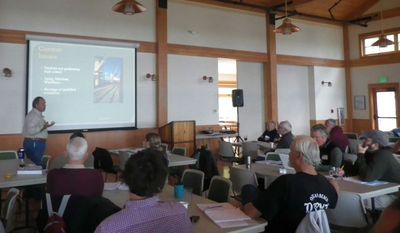
Presentations and panel sessions!
After presentations were over for the evening, I retired to the bonfire by the beach. Conferees gathered around the fire to ward off the cool breeze rolling off the water and as the cedar crackled the sounds of homemade guitars whanged out into the night. One of the classes during the day had taught students the process of building a cigar box guitar and how to use the process to teach students the math involved in making music. The four stringed guitars sounded pretty good by the campfire with a glass slide and out of tune voices! We all had a great time that evening and turned in happily exhausted.
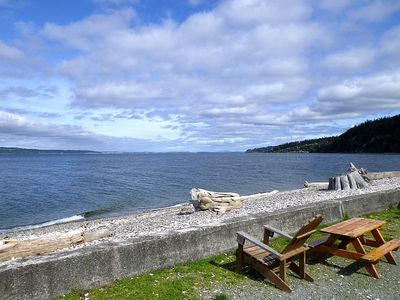
When the sun shines on the Puget Sound, it shines big!
Sunday morning was go-time for the building class I had signed up for. We spent an amazingly short three hours building wooden hand planes. The purpose of this class, like many of the others, was to use it as a teaching example on how you have to have tools to make tools, and some of these tools are personal confidence, basic math, and an understanding of the science behind tool use. While we didn’t completely finish them, I brought home the beginnings of two very nice planes which willl compliment my collection! The class was expertly taught and guided by Tim Lee, boatbuilder at the Northwest School of Woodenboat Building.
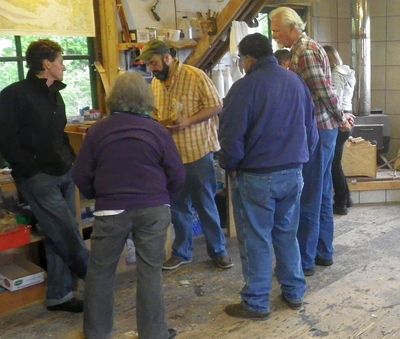
Tim teaching plane building.
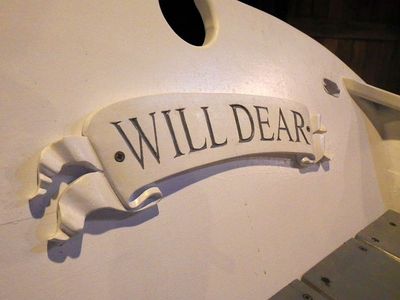
Sunday afternoon was spent in a wrapping up session for the Teaching with Small Boats Conference and getting started with the second half of the conference, the Build to Teach section. Leading the second half was Joe Youcha, of the Alexandria Seaport Foundation (ASF). A motivating and engergetic person, Joe was introduced to me by our own LAMP Boatworks builder Maury Keiser. Before moving to St. Augustine Maury and his wife, Phyllis, volunteered extensively with the ASF. Mr. Youcha has put together substantial programming to teach school kids how to learn, or bolster, math and science skills. Using simple but elegant exercises and hands-on activities, students learn fractions, the vocabulary of science and math, and can even get into complex geometry and trigonometry, depending on grade level and necessity. Working the the Carpenter’s Union, the Computer Science Corporation, and the Office for Naval Research, the Build to Teach program has proven itself as a leading model in how to teach students using boats as the pedagogical medium. I urge you to learn more about this program, and I expect that we will be borrowing heavily from it as we seek to expand our visitor experience and community engagement. Towards the end of the training session I had to excuse myself due to a touch of the flu, but Joe’s innovative programming is all duplicated and availble to us instructor trainees online and I won’t miss anything but the personal delivery. I want to thank Joe for his energy in putting this together and providing the great experience.
By the time both sessions were over I had been at Cama Beach for almost five days and, despite the beauty of the Pacific Northwest, was ready to return to the sunny south. Loaded with many great memories, lots of new friends and colleagues, and new ideas for the Lighthouse, I boarded a plane in Seattle and headed east, where I arrived back in Jacksonville about midnight on Wednesday.
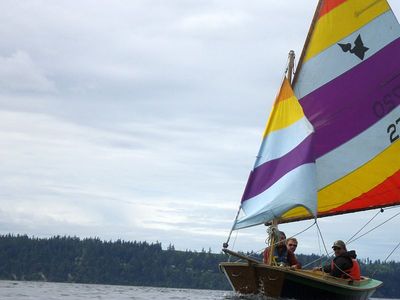
A little sailing on cool waters by the boys from San Fransisco Maritime. Go Barnacle Bill!
LAMP, the Lighthouse, and I would like to thank everyone who made this conference possible, and helped to make it possible for us to attend. Tyson Trudel and Christine Heller both did a bangup job of putting together a wonderful experience for each attendee and organization. Many thanks too, to Betsy Davis and Dick and Coleen Wagner for their support and guidance to the Center for Wooden Boats. For the Build to Teach session, Joe Youcha and the Alexandria Seaport Foundation deserve a round of applause. Their kit boats, and original design, the “Bevin’s Skiff”, has seen close to 2,000 hulls built, and many of them by family build days and youth training exercises. Thank too to the staff of Cama Beach State Park, a super place to visit!
Museums are no longer simply about dusty exhibits of collections. As we have been for years, and will continue to be, the St. Augustine Lighthouse & Museum is a home for research, for discovery, and for learning. It was a nice opportunity to meet with other organizations of like-mind to share notes, to listen, and to learn about how we can be most impactful in our missions; how to be most effective with our energy. Stay tuned and look for future programming from us, it may just involve you, a piece of wood, and an imagination turned loose!
